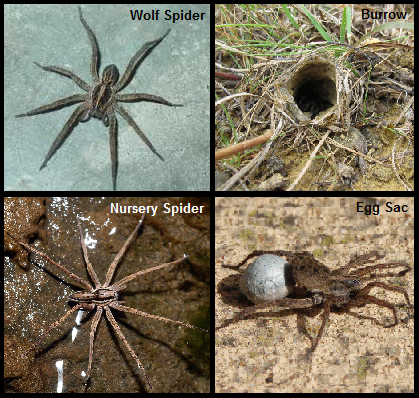These Spiders Don’t Weave Webs!
Three Virginia Spiders do not weave webs, but instead use alternative methods for hunting:the Goldenrod Crab Spider, the Jumping Spider, and the Wolf Spider.
Goldenrod Crab Spider
Hunting Technique: Goldenrod Crab Spiders use their silk as safety drag-lines, as well as to make their egg sacs. Drag-lines are similar to rescue lines that humans use, where the spiders swing down the line to catch their prey, and then climb back up the line to safety. Their main food source are insects that land on flowers, such as bees, butterflies, moths, and wasps.
Favorite Hiding Spots:
- In gardens, meadows, and fields
- Near wood edges and shrubbery
- Favorite hiding spot is inside a flower, especially daisies and goldenrod flowers (hence their name)
 Defense Mechanism: Golden Rod Crab Spiders are known for their camouflaging ability, so be careful the next time that you stick your nose in a flower! Their camouflage helps them to blend into flowers so that they are invisible to predators and prey. Since they prefer to hide in daisies and goldenrod flowers, the main two colors they change between are white and yellow. They also have a back up plan if they happen to be spotted by a predator, which is to retreat by dropping off the flower and using a drag-line. Then, when the predator is gone, they can climb back up the drag-line to return to the flower.
Defense Mechanism: Golden Rod Crab Spiders are known for their camouflaging ability, so be careful the next time that you stick your nose in a flower! Their camouflage helps them to blend into flowers so that they are invisible to predators and prey. Since they prefer to hide in daisies and goldenrod flowers, the main two colors they change between are white and yellow. They also have a back up plan if they happen to be spotted by a predator, which is to retreat by dropping off the flower and using a drag-line. Then, when the predator is gone, they can climb back up the drag-line to return to the flower.
Fun Fact: It can take these spiders up to a month to change their color from white to yellow, but it only takes them a week to change from yellow to white!
Jumping Spider
Hunting Technique: Jumping Spiders are very active hunters! They closely stalk their prey through leaves and grass before leaping onto them. If they are jumping from a high place, they will use a silk drag-line in case they miss their target. This way they don’t fall on the ground and can climb back up to try again. This is used the same way the drag-line is used in the Goldenrod Crab Spider.
Favorite Hiding Spots:
-
In woods, grassy areas, and in gardens
-
Around fallen leaves and tree limbs
-
Flowers and stones (where they can jump from)
-
Occasionally inside a house
 Defense Mechanism: Jumping Spiders have special colors (mainly black, white, and gray around Virginia) to help them hide inconspicuously inside holes and crevices. They also use their jumping ability to quickly hop away from their predators. Additionally, male jumping spiders perform a showy courtship dance to attract females while making sure that the female doesn’t try to eat the male.
Defense Mechanism: Jumping Spiders have special colors (mainly black, white, and gray around Virginia) to help them hide inconspicuously inside holes and crevices. They also use their jumping ability to quickly hop away from their predators. Additionally, male jumping spiders perform a showy courtship dance to attract females while making sure that the female doesn’t try to eat the male.
Fun Fact: Jumping Spiders are able to jump more than 40 times their body length!
Wolf and Nursery Spiders
Hunting Technique: Wolf and Nursery spiders are very fast runners, with fantastic eye-sight, powerful jaws, and extreme sensitivity to vibrations, all of which are used to their advantage while hunting. These spiders normally stalk their prey, then pounce on them and bite them with their very strong jaws. They usually target small insects such as beetles, crickets, earwigs, flies, and ants. These spiders do spin silk, but will only do so to create an egg sac. Females will hold their egg sacs with their jaws, spinnerets, and legs, under their body to protect them. This causes them to have to walk on “tiptoes” to keep the large egg sac from dragging on the ground.
- Moist areas in underbrush, bushes, woods, grasses, meadows, and fields
- On the ground, in open fields and forests
- Resting under leaves or stones in shaded areas
- Sometimes they dig a burrow that is lined with silk and wait for prey to get just a little too close!
Defense Mechanism: The dark coloration of Wolf and Nursery Spiders helps them to hide and blend into their environment. They tend to hide under leaves and stones to protect themselves from predators, and even camouflage their burrows with twigs, sticks, and leaves. They also use their keen eyesight and sensitivity to vibrations to stay away from large predators, as well as for hunting. The Nursery Spider is also capable of running over the surface of water and diving in for a period of time.
Fun Fact: If you shine a flashlight on Wolf or Nursery Spiders in the dark, their eyes will reflect the light with a silvery color. This reaction is caused by tissue located in the back of their eyes that make it possible for them to see at night!



































































